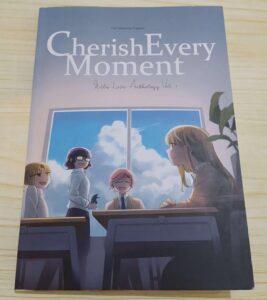 Hello! Lena Tama is here again! Unlike my previous article for my Suara Kita (Our Voices) LGBTQ+ community, this article is entirely personal but still matters a lot for Indonesian audiences. On this occasion, I’m reviewing a local yuri anthology book called Cherish Every Moment by a group of yuri mangaka called Yuri Nakama. If you have the chance, say hello to them on their Facebook page!
Hello! Lena Tama is here again! Unlike my previous article for my Suara Kita (Our Voices) LGBTQ+ community, this article is entirely personal but still matters a lot for Indonesian audiences. On this occasion, I’m reviewing a local yuri anthology book called Cherish Every Moment by a group of yuri mangaka called Yuri Nakama. If you have the chance, say hello to them on their Facebook page!
This yuri anthology book has been quite an enigma since I bought it at the Comic Frontier (Comifuro) convention in May this year. Sometimes I wondered if this book would be worth reviewing or not due to its circumstances, but I did it anyway.
Cherish Every Moment consists of five one-shot titles, but not all of them are in manga format. Of those titles, three of them are manga, one of them is a short story, and the last one is… hard for me to explain, but again I’ll get to it as well. Their stories have one defining theme: To cherish every moment, however we can.
I’m going to review each title and provide a snippet of them as they are in the book. Here goes!!
1. Loop of Second Chances by Pianno
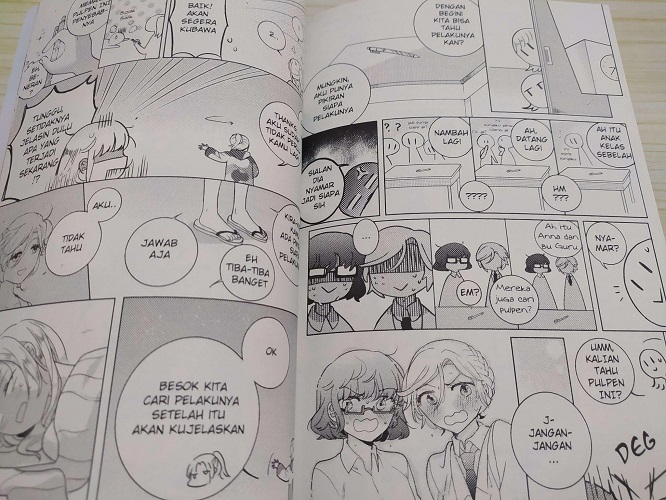 Our first title is a one-shot manga about Lucy, a third-grade high school student who gives up her love after being rejected by her crush Anna during their graduation ceremony. Or at least, that’s what Jean dreamed of before she woke up and found out that she looped back in time during her second year, giving her a second chance to get closer to Anna.
Our first title is a one-shot manga about Lucy, a third-grade high school student who gives up her love after being rejected by her crush Anna during their graduation ceremony. Or at least, that’s what Jean dreamed of before she woke up and found out that she looped back in time during her second year, giving her a second chance to get closer to Anna.
Except, it’s already over 50 times by now and every time loop results in the same conclusion: Anna rejects Lucy because she has her eyes on someone else and Lucy’s friend Jean keeps bullying their teacher Mrs. Katerina until their graduation. At this point, Lucy resigns her fate to repeat one year of her high school moment forever like a curse from God.
But not everything is always the same. One time, Lucy picked up an unassuming pen which remained in her possession for dozens of time loops. Anna and Jean allude to their high school moments lasting forever, and Mrs. Katerina is slowly getting closer to Lucy with each passing cycle.
Eventually, Lucy and Jean figure out who’s behind this endless time loop: Mrs. Katerina and Anna. Not only is Mrs. Katerina a witch and the unassuming pen is her magic wand, but Jean is also her superior. Anna asked Mrs. Katerina to perform a magical time loop so that she can be with her crush, Jean, for a while longer, which Mrs. Katerina did thanks in part to her blossoming affection toward Lucy.
Finally having clarity, Lucy accepts the truth and Mrs. Katerina returns the time flow to normal. For the last time, these four girls relieve their high school moment with Anna finally getting closer to Jean and Lucy giving the depressed Mrs. Katerina a chance to get closer to her.
And that’s the end of this story. It took me until the end of the story to realize it was a romcom student x teacher story, but even then that’s quite a stretch given the many bizarre twists. The artstyle is rather simplistic and cute, but it doesn’t detract from its overall story. It kept me guessing for a while, and I like it.
Enjoyment: 6/10
Characters: 7/10
Yuri: 7/10
2. Debur Amarilis (Splash of Amaryllis) by Saxifraga
 This short story depicts the aftermath of the war between the nations of Floralys and Orkanius which concluded with the defeat of Orkanius and the unification under Floralys. Kairi Physeter, a herbalist and former paramedic for Orkanius army remained in Floralys to help the war-torn areas and victims of war as the only healer available, at least until the arrival of another healer called Elena Crescent, a renowned white mage and leader of Floralys paramedic battalion.
This short story depicts the aftermath of the war between the nations of Floralys and Orkanius which concluded with the defeat of Orkanius and the unification under Floralys. Kairi Physeter, a herbalist and former paramedic for Orkanius army remained in Floralys to help the war-torn areas and victims of war as the only healer available, at least until the arrival of another healer called Elena Crescent, a renowned white mage and leader of Floralys paramedic battalion.
Despite initially standing opposite each other during the war, Kairi and Elena gradually got closer as they reached a level of intimacy unbound by labels over the course of three years. They loved each other and respected the boundary to maintain professionalism at their respective jobs.
One day, an announcement comes in which states that Orkanius’ revitalization has completed and the citizens in Floralys, including Kairi, may return home. After three years thinking only about her job and Elena, the thought of returning to Orkanius suddenly hits Kairi. Her former greenhouse, her Master Herbalist who had long passed away, the subtropical climate of Orkanius which is vastly different to Floralys’ tropical climate, and her own hometown.
As much as Kairi wants to return home, it would mean being separated from the one person that matters so much to her. This is the first time Kairi ever feels distraught by that mere thought and she’s afraid of saying it to Elena, afraid that Elena would feel indifferent if they’re apart after all these three years and their relationship which they have built would crumble.
However, Elena caresses Kairi gently, reminding her that she will always respect Kairi’s decision and that nothing will ever replace Kairi in her heart even if they’re physically apart from each other. At this moment, Kairi realizes how much they love and respect each other, and how far their relationship has come.
Elena follows Kairi as they travel to Orkanius together, back to where Kairi began her journey as a herbalist. Kairi decides to continue her late Master’s study someday, rebuild the untidy greenhouse, and become a better herbalist than she is now. In their embrace, they know that they’re ready to make the decision when the time comes and the bond they have is unbreakable.
I didn’t expect much from this title and ended up intrigued by it. The world building is compact but pretty imaginative to me, and the characters are well-written; they have deep love for each other and they communicate their feelings well.
Overall, I enjoyed this story so much. I hope they can expand the story of Kairi and Elena in the future. One can dream…
Enjoyment: 9/10
Characters: 9/10
Sapphic: 8/10
3. The Time Jacker by LoveJuice
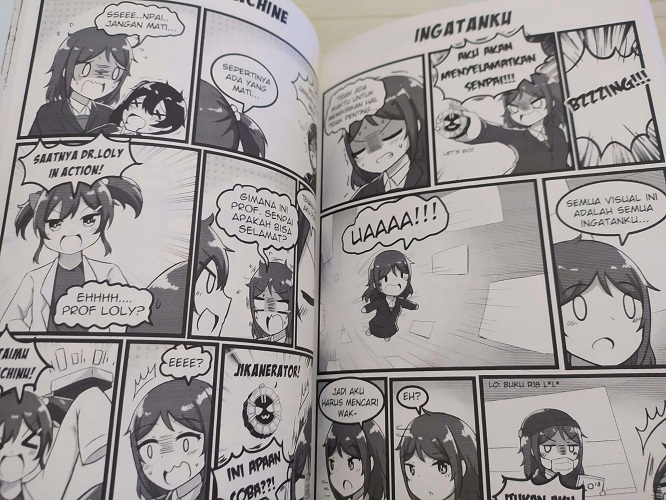 I’m going to be honest; I don’t like cute-girls-doing-cute-things stories that don’t add anything else to the table, and this manga does just that. It’s a story about a cute girl doing a time loop to turn back time and save her cute crush.
I’m going to be honest; I don’t like cute-girls-doing-cute-things stories that don’t add anything else to the table, and this manga does just that. It’s a story about a cute girl doing a time loop to turn back time and save her cute crush.
An unnamed senpai steals her unnamed kouhai’s coffee and dies due to said coffee. Distraught over her beloved senpai’s death, an eccentric cute engineer called Professor. Loly comes to the rescue and gives the kouhai a time machine in the form of a stopwatch to return to the past and save senpai from the deadly coffee.
Indeed, kouhai goes back to five minutes before senpai’s death using the stopwatch, only to meet her past self who got persuaded to throw away the deadly coffee.
Although initially afraid kouhai cannot return to the present time because the time machine/stopwatch only works once before needing to change its battery, it doesn’t matter since she only jumped to the past five minutes ago. Things shortly return to normal and kouhai finds her tsundere senpai alive and jolly. Everything’s as it should be, except for the godzilla in the background wrecking havoc.
There’s a fine line between writing a good comedy and trying too hard to be funny. This title does both simultaneously and I don’t enjoy it that much. Adding to that is the overly cute artstyle that makes the story a bit aggravating whenever it tries too hard to be funny. Many things about it feel too basic and not memorable enough for me.
Bonus points if you see the kouhai as Nishikino Maki and the senpai as Yazawa Nico from Love Live.
Enjoyment: 5/10
Characters: 4/10
Yuri: 3/10
4. Our Memories Are Stored in the Clouds by Sakakibara Ryoichi
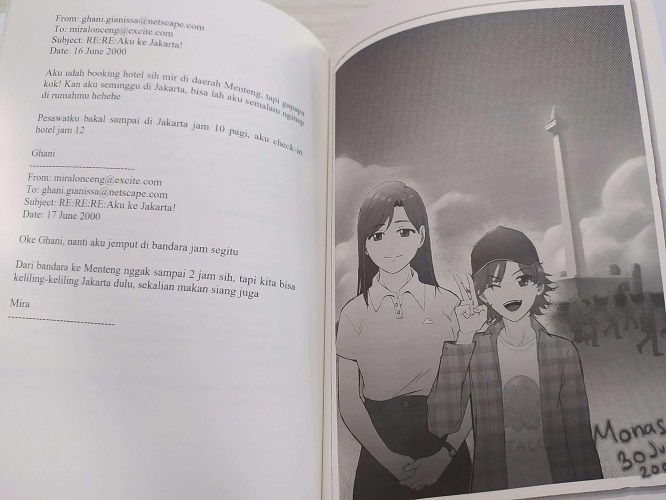 Now this is the real deal, possibly the biggest selling point of this yuri anthology book and one of the major reasons I want to review it. This is a short story being told in a very unorthodox format: A dialog between two girls in 1999 via email messages.
Now this is the real deal, possibly the biggest selling point of this yuri anthology book and one of the major reasons I want to review it. This is a short story being told in a very unorthodox format: A dialog between two girls in 1999 via email messages.
Before the advent of mainstream internet access and social media, there were only private forums where people could communicate beyond borders like Compuserve where fellow computer enthusiasts across the world shared their thoughts on software developments, tech news, and the likes. Among many forum members who were mostly foreigner guys, Mira was one of the only two Indonesian female members there with the other one being Ghani.
Starting from February 18, 1999, Mira and Ghani became acquaintances on Compuserve and shared their passions with all things computer. Ghani took a liking in software development thanks to her father being a former lecturer for Institut Teknologi Bandung (Bandung Technology Institute) and that she had graduated from college a year earlier, whereas Mira was still attending college at Budi Luhur University during her final semesters and she wished to develop a commercial storage system in the future.
Eventually, Ghani received a scholarship at MIT for advanced web designing while Mira graduated college and was starting a job as a web technician for a bank which she didn’t like due to the disrespect from her male colleagues. Many times, they shared their dreams and frustrations, as well as how much they wanted to meet each other but failed twice.
However, with Ghani’s eventual departure to the US in the Fall season in 2000 for her scholarship, the opportunity finally arrived for them to meet up in real life for the first time. Ghani stayed in Jakarta for one week before her flight and both she and Mira spent their time together, including taking a commemorative picture at Monas (National Monument) on June 30, 2000, capturing Mira’s calm and timid expression which contrasted Ghani’s upbeat and cheerful personality, as well as the genuine camaraderie between the two computer enthusiasts.
Ghani and Mira grew ever closer together in spite of Ghani living her new life in the US. They never stopped sending emails to each other and always poured their feelings into each message, including their desire to experience valentine day together with Ghani wishing to savor Mira’s homemade chocolate someday.
After working for Bina Nusantara University for some time, Mira received an invitation for a Master’s Degree at either Stanford or UC Berkeley next year. Meanwhile, Ghani was also about to participate in her first-ever conference at UCLA which would become a regular activity for her to travel to Los Angeles. With every opportunity coming together, they couldn’t be more overjoyed at the thought of finally meeting up again, this time in the US.
On September 1, 2001, Ghani was excited that her conference at UCLA would come sooner in mid-September thanks to her promotion as a panelist for the conference. With Mira’s blessings, Ghani anxiously awaited her flight from Logan Airport, Boston to LA International Airport on September 11, 2001.
And then, I briefly stopped reading the story. My fingers trembled in fear, realizing that some details mimicked a very particular event which I wish wouldn’t occur in this story. I kept wishing I wouldn’t have to open the next page to find out what really happened after that. But then, I swiped to the next page and the story skipped to September 11, 2021. 20 years had passed since Ghani’s last email and Mira broke the silence by sending an email, along with a picture of her in her 40s right next to the 9/11 Memorial with Ghani’s name engraved on it.
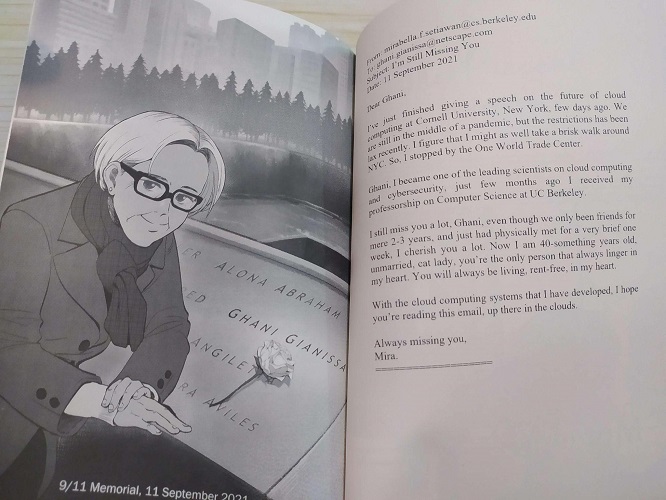 In the last 20 years since they talked, Mira became one of the leading scientists on cloud computing and cybersecurity and she wished to pay her respect for the victims of 9/11. Mira had grown so much, but she remained a single, unmarried cat-lady whose heart only had a place for Ghani, and she hoped her cloud computing systems could send this one email to Ghani up in the sky, among the clouds.
In the last 20 years since they talked, Mira became one of the leading scientists on cloud computing and cybersecurity and she wished to pay her respect for the victims of 9/11. Mira had grown so much, but she remained a single, unmarried cat-lady whose heart only had a place for Ghani, and she hoped her cloud computing systems could send this one email to Ghani up in the sky, among the clouds.
I bursted into tears when I read it for the first time. And after consecutive readings, I still find myself crying so much. Never did I expect a short story with such an unorthodox storytelling method would make me care so much for two people who deserve the best in their life. This stupid, simple, sapphic story…
Enjoyment: 10/10
Characters: 10/10
Sapphic: 7/10
5. The Present by Magnolia Team
 Whew, that was some powerful angst, so let’s end this yuri anthology on a more cheerful note. The Present is a quick, simple one-shot manga about a blonde girl who seems to have a bad day. She almost forgot about her black-haired girlfriend’s birthday, so she rushed to the nearest florist and bakery to buy a nice set of presents, only to then get caught in the rain and return home rather late.
Whew, that was some powerful angst, so let’s end this yuri anthology on a more cheerful note. The Present is a quick, simple one-shot manga about a blonde girl who seems to have a bad day. She almost forgot about her black-haired girlfriend’s birthday, so she rushed to the nearest florist and bakery to buy a nice set of presents, only to then get caught in the rain and return home rather late.
The black-haired girl awaits her at home and is worried sick, knowing that the blonde girl goes home rather late and gets drenched so badly. Despite the blonde girl’s bad luck at surprising her girlfriend, the black-haired girl insists that what matters the most is her beloved girlfriend being there for her.
In a rather quiet scenery, they both take a bath together, enjoy homemade dinner, and close the day with a simple birthday celebration on each other’s embrace. And that’s it.
The Present is a short and sweet sapphic story. The blond girl and black-haired girl love each other so much in a depiction that is wholly respectful and pretty relatable.
I cried a bit when reading this story the first time but for a different reason than the previous story. I love this simple love story and I wish us Indonesians could experience it freely as well.
Enjoyment: 7/10
Characters: 7/10
Yuri: 8/10
—
And that’s all there is to Cherish Every Moment. Yuri Nakama doesn’t sell this book outside of the local Japanese pop culture conventions, not even in their digital form. People can only buy the physical release during the events which causes accessibility issues for local readers in Indonesia, especially for overseas people. And once the events are over, there’s no way of buying the previous works again.
This is one huge reason I wasn’t sure if Cherish Every Moment would be a book worth reviewing on the internet. I didn’t know if people would want to hear the review of a book that they couldn’t access easily among locals, let alone overseas audiences.
However, the Yuricon community encouraged me to write this review anyway, knowing that this simple yuri anthology book represents so much more for the LGBTQ+ community in Indonesia. In a country where gender and sexual minorities are neither condemned nor protected by the law, we are prone to discrimination by the people each passing day with little to no chance to speak up for ourselves.
Among the handful of local queer books like the ones available on Yuri Nakama and my organization Suara Kita, most of them are produced in-house with little easy access on the bookstores and online marketplace. I’m more representing Suara Kita on this one, but I feel like we have similar risks to face as Yuri Nakama in that our literature is prone to being burned down, torn apart, or review-bombed by the majority of people, as it happened a couple of times in the past.
The fact that there’s a small but dedicated community who produces yuri manga in a respectful manner and a bit regularly, albeit with accessibility issues, is very fascinating to me and they deserve more exposure. I hope this article can help raise awareness of Yuri Nakama’s contributions to queer people in this country. Whether they’re for queer people, yuri fans, anime and manga fans, or the common audiences, their books are worth buying and reading for their contents, to provide critics that can help them grow, and for what they represent.
And last but not least, I hope they can begin selling their books in digital form for easier accessibility among us locals and hopefully the overseas readers as well. I know I can recommend some good books from them just like this yuri anthology book, Cherish Every Moment.
*About author
Lena Tama is an Indonesian trans woman, as well as a translator and freelance writer since 2016. Lena began indulging in the world of journalism in 2020 by joining The Jakarta Post. Aside from writing articles, Lena is also involved in advocating LGBTIQ+ rights and other groups of minorities in Indonesia
![]() Em Evergreen is a lonely lesbian with a manga addiction. Find her at linktr.ee/em.evergreen.Just Friends is a one volume Yuri manga by Spanish mangaka Ana Oncina. Originally published by Planeta Cómic in Spain in 2021, the English edition comes to us courtesy of Tokyopop, with translations by Nanette Cooper-McGuinness. Just Friends was awarded a silver medal at the Japanese Ministry of the Exterior’s International Manga Awards in 2023.Just Friends has the form of a manga, with right-to-left paneling and Japanese-language sound effects, but the lower-line-count art style hints at its overseas origin. It’s an opportunity to read a different type of Yuri, one that plays with the tropes of a culturally distinct adolescence – no sailor uniforms, student council officers, or onigiri are in evidence. Instead our story is set at sleep-away camp, where our teenage characters wear graphic tees and eat pizza and baloney sandwiches.Our protagonist, the introverted Erika, is reluctantly packed off to said camp without any close friends. On the bus there, she meets her polar opposite Emi, who takes an immediate interest in Erika and declares them “inseparable” before they even arrive. The story of their whirlwind relationship that summer is framed by more brief flash-forwards into their future, where we see them meet again as thirty-somethings. As with any good real-life sleep-away camp, the setting gives Erika the chance to step outside her comfort zone, figure out some things about herself, and perhaps explore that most new and exciting phenomenon to a teen – romance.To some young adult readers, especially queer ones raised in a similar context, the story will at times be almost painfully relatable. The realistic depictions of social anxiety, bullying, awkwardness, and underage-drinking-fueled misadventures might resonate a bit too strongly for comfort, but you’ll likely chuckle more than cry. Erika and her peers don’t have the communication or conflict resolution skills of adults, but their conflicts aren’t the focus. This is a romance at its core, with a side of navigating heteronormative expectations while figuring out who you are.Just Friends is very much not a Yuri without lesbians. Its mix of LGBTQ issues and romance is distinguished from recent standouts like Shio Usui’s Doughnuts Under a Crescent Moon or Sakaomi Yuzaki’s She Loves to Cook, She Loves to Eat by its strong focus on the drama of adolescence. In that respect, it calls to mind Yuhki Kamatani’s Our Dreams at Dusk, though it’s lighter in tone and less ambitious in scope. Just don’t go into Just Friends expecting a neat and tidy ending, or a sweet story of first love. It’s too grounded in the complexities of real-world romantic relationships, teenage and adult, to give us that. Like all good one volume manga, it leaves you wanting more.Art – 5, effective if not awe-inspiringStory – 8, a nostalgic, bittersweet romanceCharacters – 6, more realistic than memorableService – 3, sex isn’t ignored, but the teens aren’t leered at or sexualizedYuri – 10, Houston, we have lesbians (and/or bisexuals)Overall – 7
Em Evergreen is a lonely lesbian with a manga addiction. Find her at linktr.ee/em.evergreen.Just Friends is a one volume Yuri manga by Spanish mangaka Ana Oncina. Originally published by Planeta Cómic in Spain in 2021, the English edition comes to us courtesy of Tokyopop, with translations by Nanette Cooper-McGuinness. Just Friends was awarded a silver medal at the Japanese Ministry of the Exterior’s International Manga Awards in 2023.Just Friends has the form of a manga, with right-to-left paneling and Japanese-language sound effects, but the lower-line-count art style hints at its overseas origin. It’s an opportunity to read a different type of Yuri, one that plays with the tropes of a culturally distinct adolescence – no sailor uniforms, student council officers, or onigiri are in evidence. Instead our story is set at sleep-away camp, where our teenage characters wear graphic tees and eat pizza and baloney sandwiches.Our protagonist, the introverted Erika, is reluctantly packed off to said camp without any close friends. On the bus there, she meets her polar opposite Emi, who takes an immediate interest in Erika and declares them “inseparable” before they even arrive. The story of their whirlwind relationship that summer is framed by more brief flash-forwards into their future, where we see them meet again as thirty-somethings. As with any good real-life sleep-away camp, the setting gives Erika the chance to step outside her comfort zone, figure out some things about herself, and perhaps explore that most new and exciting phenomenon to a teen – romance.To some young adult readers, especially queer ones raised in a similar context, the story will at times be almost painfully relatable. The realistic depictions of social anxiety, bullying, awkwardness, and underage-drinking-fueled misadventures might resonate a bit too strongly for comfort, but you’ll likely chuckle more than cry. Erika and her peers don’t have the communication or conflict resolution skills of adults, but their conflicts aren’t the focus. This is a romance at its core, with a side of navigating heteronormative expectations while figuring out who you are.Just Friends is very much not a Yuri without lesbians. Its mix of LGBTQ issues and romance is distinguished from recent standouts like Shio Usui’s Doughnuts Under a Crescent Moon or Sakaomi Yuzaki’s She Loves to Cook, She Loves to Eat by its strong focus on the drama of adolescence. In that respect, it calls to mind Yuhki Kamatani’s Our Dreams at Dusk, though it’s lighter in tone and less ambitious in scope. Just don’t go into Just Friends expecting a neat and tidy ending, or a sweet story of first love. It’s too grounded in the complexities of real-world romantic relationships, teenage and adult, to give us that. Like all good one volume manga, it leaves you wanting more.Art – 5, effective if not awe-inspiringStory – 8, a nostalgic, bittersweet romanceCharacters – 6, more realistic than memorableService – 3, sex isn’t ignored, but the teens aren’t leered at or sexualizedYuri – 10, Houston, we have lesbians (and/or bisexuals)Overall – 7


